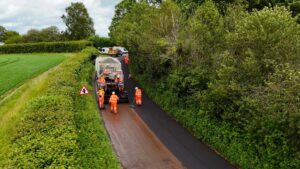The Road Surface Treatments Association (RSTA) has launched ‘game-changing’ guidance to enable local authorities to understand and demonstrate for the first time the carbon savings they are making when using surface treatments.
The RSTA Carbon Emissions for Road Surface and other Maintenance Treatments Report and Guidance was launched at the RSTA’s annual conference on 13th April at Celtic Manor in Wales.
The guidance, developed for local highway authority Asset Managers and other decision makers, will enable them to plan their future maintenance programmes and demonstrate the carbon savings they have made and are making by implementing whole life carbon and cost lifecycle asset management.
This is the first time all the major treatments including conventional asphalts have been calculated and compared in accordance with the International Standards. It includes the A1 – A3, A4, A5 and total C02e emissions for each treatment, with sample comparisons for schemes using different materials and methods.
The newly developed guidance is what local highway authorities have been waiting for, an endorsed one stop carbon guidance for direct comparisons across materials and methods and will be a game changer for the way forward in reducing carbon (and costs) during the operational life of a road or footway. It paves the way for managing other highway assets in a similar efficient way when their carbon lifecycle emissions are also calculated.
Produced by PYE-Management Ltd, on behalf of the RSTA, the report details the carbon calculations for each of the surface treatments, including: asphalt preservation, geosynthetics, ironworks, In-situ recycling, rejuvenation, retexturing, slurry microsurfacing, spray injection patching and surface dressing.
Paul Boss, Chief Executive of the RSTA said: “This is game-changing guidance for local authorities that will enable them to understand exactly what carbon they are saving by using different surface treatments. This means they can not only plan more effectively with their forward maintenance programmes, but finally have clarity around the carbon and financial savings they are making.
“
This guidance will help local authorities cut through the confusion and doubt about how carbon savings are calculated with regards to the highway maintenance process and in particular showing how much carbon savings can be made from incorporating surface treatments as part of a proactive asset management strategy.”
Currently, there is no robust guidance like this that uses standards led assessments which means, until now, there has been a lack of standardisation and consistency in producing carbon footprints for surface treatments.
The purpose of this report was to follow a required methodology for producing a carbon footprint and apply this to the different treatments as well as the conventional methods of resurfacing or patching, to determine which approach has a lower carbon footprint.
The report will be reviewed and updated no less than every three years, to ensure that figures are accurate and appropriate to the current methods and working practices.
Embodied carbon is the carbon dioxide (CO₂) emissions associated with materials and construction processes throughout the whole lifecycle of a building or infrastructure. It includes any CO₂ created during the manufacturing of building materials (material extraction, transport to manufacturer, manufacturing), the transport of those materials to the job site, and the construction practices used.
(Picture –






















